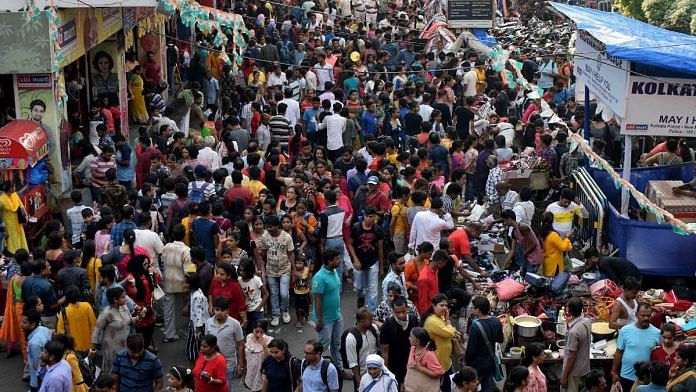New Delhi: India’s Muslim population has grown “somewhat faster” than other religious groups because of fertility differences, but there have been only “modest changes” in the overall religious makeup of the population since 1951, when the first post-Independence census was conducted.
These are the findings of an analysis by US-based Pew Research Center published Tuesday. Titled ‘Religious Composition of India’, the report seeks to study India’s religious demography over the years, and describes fertility as “by far the biggest driver of the modest amount of religious change in the decades since Partition”.
The report attributes the “modest” changes “in part to declining and converging fertility patterns”.
Every religious group in India “has seen its fertility fall, including the majority Hindu population and Muslim, Christian, Sikh, Buddhist and Jain minority groups”, the report states.
While Muslims have the highest fertility rate among India’s major religious groups, their total fertility rate “has declined dramatically”, it says.
The report says there are usually three factors that cause religious groups to shrink or expand — migration, religious conversion and fertility — before elaborating on why fertility explains the trends witnessed in India.
“Migrants leaving India outnumber immigrants three-to-one, and religious minorities are more likely than Hindus to leave,” the report adds.
Similarly, religious conversion had a “relatively small impact” on India’s overall composition, with 98 per cent of Indians still identifying with the religion in which they were raised, it says.
Substantiating what it means by “modest changes”, the report cites census data from 1951 to 2011. It notes that there has been a “modest decline” in the percentage of Hindus as a share of population, and a “modest rise” in the figure for Muslims.
Hindus, it says, comprised 84.1 per cent of the population in 1951, and 79.8 per cent in 2011, while Muslims comprised 9.8 per cent of the population in 1951, and 14.2 per cent in 2011.
Talking about the report, lead researcher Dr Stephanie Kramer said, “As far as we know, this is the first time researchers have quantified fertility rates, migration and conversion to compare their potential impacts on demographic change in India side by side.”
Also Read: Pew report tells why Indians don’t assert on pandemics, unemployment, economic exploitation
On fertility rates
The report found that gaps in fertility rates between India’s religious groups have shrunk over the years.
Fertility rate refers to the average number of children born to a woman in childbearing age (15-44 years). While Muslim women were expected to have an average of 1.1 more children than Hindu women in 1992, the gap had shrunk to 0.5 by 2015, the report says.
Using a statistical technique known as multilevel mixed-effects analysis, the report tries to see if education, wealth and place of residence played a role in these gaps, Kramer said.
Based on a cohort of women who were in their 40s when they took the National Family Health Survey in 2015, the report found that if all the women had an average amount of wealth and education, were the same age and lived in the same places, Hindu women would be predicted to have 0.9 fewer children than their Muslim counterparts, on average.
According to the report, all religious groups have shown a major decline in fertility rates between 1992 and 2015. Muslims have the highest fertility rate, followed by Hindus. This reflects a long-standing pattern since 1992, adds the report.
‘Christians may be undercounted’
In one section, the study notes that India’s population has more than tripled since Partition and, accordingly, all religious groups have grown in size.
It states that Indians “who say they are Christian” rose to 2.8 crore from 0.8 crore, but adds that this could be an undercount.
“People who indicate that they are Christian on the census are not able to also identify as belonging to Scheduled Castes. Members of Scheduled Castes are eligible for government benefits, reportedly prompting some people in that category to identify as Hindu when completing official forms,” says the study.
Dalits who identify as Christians and Muslims can’t avail of reservation benefits and remain excluded from the Constitution (Scheduled Castes) Order, 1950.
In late June, the Pew Research Center released a survey that found Indians show an enthusiasm for religious tolerance, but prefer to live and marry within their community. The survey drew flak from several political scientists, academics and ethnographers, with some saying that the findings were “too good to be true”, and that caste and class should have also been included as larger factors in the survey.
(Edited by Sunanda Ranjan)
Also Read: Who is your neighbour? What we are not seeing in Pew study on India



